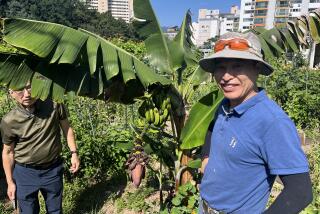Good Fried, Grilled : Bananas--Staff of Life in Rwanda
- Share via
KIGALI, Rwanda — Open the door to the government’s banana ripening room and the cockroaches run for cover on the sweating concrete walls. The aroma is familiar, thickly sweet and overpowering. Everything feels sticky.
Thousands of fingers of green fruit grow yellow here, packed to the rafters in the stifling heat.
“When you put bananas together, they produce a warmth all their own,” a banana factory official, Bernardin Kagina, said admiringly.
Bananas are more than a farm crop in Rwanda. They are part of the fabric of daily life. And they are everywhere.
In the ripening room at the banana processing plant. At the market. On top of mountains. On the backs of bicycles and people-drawn carts. Next to grass huts. On brochettes. In sofas and on wall coverings. In jam and juice. And in bottles of a husky young wine, vin de bananes.
This tiny French-speaking nation in the heart of Africa, a hilly tract of rich volcanic soil smaller than the state of Maryland, grows 2.1 million tons of bananas a year. And eats or drinks them all.
At 700 pounds per person, that is the highest rate of production in Africa and among the highest in the world.
“The status of bananas in Rwanda is really quite exceptional, even for Africa,” says Yvan Dejaegher, a European agricultural economist working with the Rwandan government.
Rwanda lies in the heart of Africa’s banana bowl, a crescent that runs from Liberia on the Atlantic Ocean through the equatorial midsection of the continent to Tanzania on the Indian Ocean.
Grown by 97% of Farmers
Bananas are grown throughout the region, but nowhere are they as important as in Rwanda. Nearly 40% of the cultivated land here is covered with the tall, broad-leafed plants, and 97% of the country’s farmers grow them, along with other crops, the government says.
These days, the challenge in the land of the banana is finding new uses for the fruit, the peels and even the plant stalks.
Making more and better use of bananas is especially important as Rwanda, already the most densely populated country in Africa, struggles against the growing pressure on farmland caused by a rapidly swelling population.
Although Rwandans grow a few bananas for eating raw, as fruit, most people prefer their bananas fried, boiled or grilled and served with beans or tomatoes at the dinner table.
“People are eating more bananas now because there are more ways to eat them,” said Patricia Nyirababimana, a banana trader at the Jiakondo Market near Kigali.
“Also, our bananas are smooth and they taste good,” the 28-year-old businesswoman added as she lifted a 50-pound banana bunch neatly onto her head for carrying.
Shadrac Bimyemzi, a lawyer in Kigali, says he’d eat bananas every day, but his wife limits him to three meals of bananas per week. Bimyemzi has 4-month-old twin girls he plans “to start on Rwanda bananas by the time they are 6 months old.”
Only about a fourth of Rwanda’s bananas are eaten, though. Most of the rest are for drinking. Banana wine is the country’s most popular beverage.
“I don’t know if it’s better than other wine, but it certainly is good,” says Christophe Boneze, a program officer for the United Nations.
President Juvenal Habyarimana frequently calls on the people to be more creative in their use of bananas, using fewer bananas for wine, which cannot be exported because it is so perishable, and more for productive exports.
The country has made some progress toward discovering new applications for its most plentiful commodity.
Craftsmen use the thin, durable skin from those stalks to make chairs, tables, place mats, coasters, trash cans and baskets, for example. Whole rooms can be decorated, a la banana. The walls of the U.N. office lobby here, for example, are covered in strips of banana plants.
Rwanda hasn’t found much of a market for any of its banana products outside the country, however. The major drawback to selling banana wine abroad, aside from its rather unusual taste, is its shelf life--shorter than that of the average quart of milk.
The country doesn’t export its bananas, either, because most of its varieties are starchy rather than sweet--ideal for cooking and wine-making but not very tasty as raw fruit. Most bananas eaten in the United States, the world’s largest importer, are sweet varieties grown in Latin America.
Banana Bread Lags
For the last 10 years, the government office devoted to developing industrial uses of Rwanda’s bananas, a research laboratory and factory atop one of the capital city’s many hills, has tried to “make decent food out of bananas,” in the words of one European diplomat who remains unconvinced.
The factory, known as Ovibar for its acronym in French, makes banana wine, of course. But its 150 employees also produce a banana liqueur, a banana jam and about 1,500 gallons a year of pungent banana juice that resembles apple cider.
Its most recent invention, introduced five years ago, was banana bread. The bread hasn’t caught on too well, although a local high school does regularly order several dozen loaves for student lunches.
“People are in the habit of eating their usual bread,” Bernardin Kagina, Ovibar’s chief financial officer, said with a shrug. “It’s difficult to show them new things.”
Undaunted, Ovibar’s three scientists have a few more projects under way. One is to make vinegar out of bananas. A second is to produce energy from rotting banana peels.
The largest part of Ovibar’s operation remains devoted to banana wine. Most days the factory makes about 500 gallons of the stuff, which is often called beer because it is fermented with sorghum and bottled in beer-sized 10- or 21-ounce containers with soda-pop caps.
Ovibar sells two brands. The more popular is the “traditional,” a milky wine with the palpable bouquet of (what else?) bananas. The highbrow version, which is clearer but with a similar taste, is called cuvee speciale des “mille collines,” the special blend from the land of a thousand hills.
The process begins when Ovibar unloads green bananas into the dark, dank ripening room. Turning yellow and soft, they are peeled by hand and mashed. The juice is extracted and left to ferment in huge vats for three days. Then it is trucked to the countryside.
But the factory makes only a tiny fraction of the estimated 3 million gallons of banana wine produced here every year.
Home Brew Popular
Most of Rwanda’s 6 million people either make wine themselves or buy it from a neighbor. Across the country, bamboo sticks mark the spots where bananas have been buried in the warm earth to ripen. They are buried again in jugs to ferment.
Ovibar’s Kagina maintains that “many people like our beer because they think it is stronger than what they make at home.” Ovibar wine is about 12% alcohol, roughly the same as an average California table wine.
A small bottle of Ovibar’s wine sells for about 45 cents, too expensive for many Rwandans, and local farmers charge about half that for their homemade brew.
Bananas have long been an integral part of the tropics. They apparently originated in Indonesia, although the word banana comes from the Mandingo tribal language in west-central Africa.
The banana plant itself is actually an enormous herb that springs from an underground stem. Each plant is cut down after producing one bunch of bananas, but the stem continues to produce new plants. Thus Rwanda’s banana farmers are blessed with a continuous harvest and regular paydays.
But nearly every arable part of Rwanda is farmland. Even the hilltops are ringed with tilled soil.
Easy to Grow
“It’s not hard to grow bananas. The difficulty is getting the land,” said Godfrois Rutemesha, 31, who has a dozen or so banana plants within a few feet of his house near Kigali.
The best way to find a farmer’s home when driving along Rwanda’s winding roads is to look for a cluster of banana plants. Some agricultural experts think having the plants so close to homes is hazardous, especially during the long rainy seasons when water collects on the leaves or in the plant’s shade, creating little farms for disease-carrying mosquitoes.
But that is of little concern to the average Rwandan. He uses the perennially moist soil beneath his banana plants for growing beans, and he appreciates the low maintenance his banana crop requires.
Rutemesha clears away a few dying branches on his banana plants every few days. When the bunch of fruit grows heavy, he may prop up its branch with a long, forked bamboo stick.
Otherwise he just harvests his bananas, sells them to the wine-makers--and then turns around and buys the type of bananas his family likes to eat.
“We’ve eaten bananas all our lives,” he said.
More to Read
Sign up for The Wild
We’ll help you find the best places to hike, bike and run, as well as the perfect silent spots for meditation and yoga.
You may occasionally receive promotional content from the Los Angeles Times.







